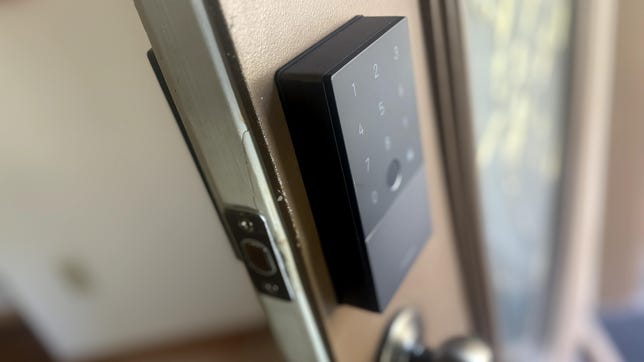
Pros
- Durable and clean design
- Accurate fingerprint and Bluetooth access
- Satisfying keypad
- Built-in Apple Home support with options for Alexa and Google Assistant
- Easy-to-learn app UI
- Plenty of temporary pass options
- Do not disturb mode
- Lock sensing and auto lock-unlock capabilities
Cons
- Requires an Aqara hub to enable extra smart home support, long-distance control and more
Few smart locks offer such a comprehensive deadbolt replacement option as the Aqara U100, a smart lock with a tough, not-too-bulky design and every access method you could desire. It also wins extra points for its Matter compatibility and support for not only Apple HomeKit but Alexa and Google Home, too. Factor in a fairly straightforward installation with a simplified app, and the U100 becomes a smart lock to beat in the current market.
The only catch? You really need an Aqara hub to access some of the most valuable features, which pushes the $230 lock’s cost even higher. Even with this recommended addition, Aqara’s lock remains one of our favorites, but you will need to dig deeper into your wallet — or wait for one of the occasional deals.
Design and durability
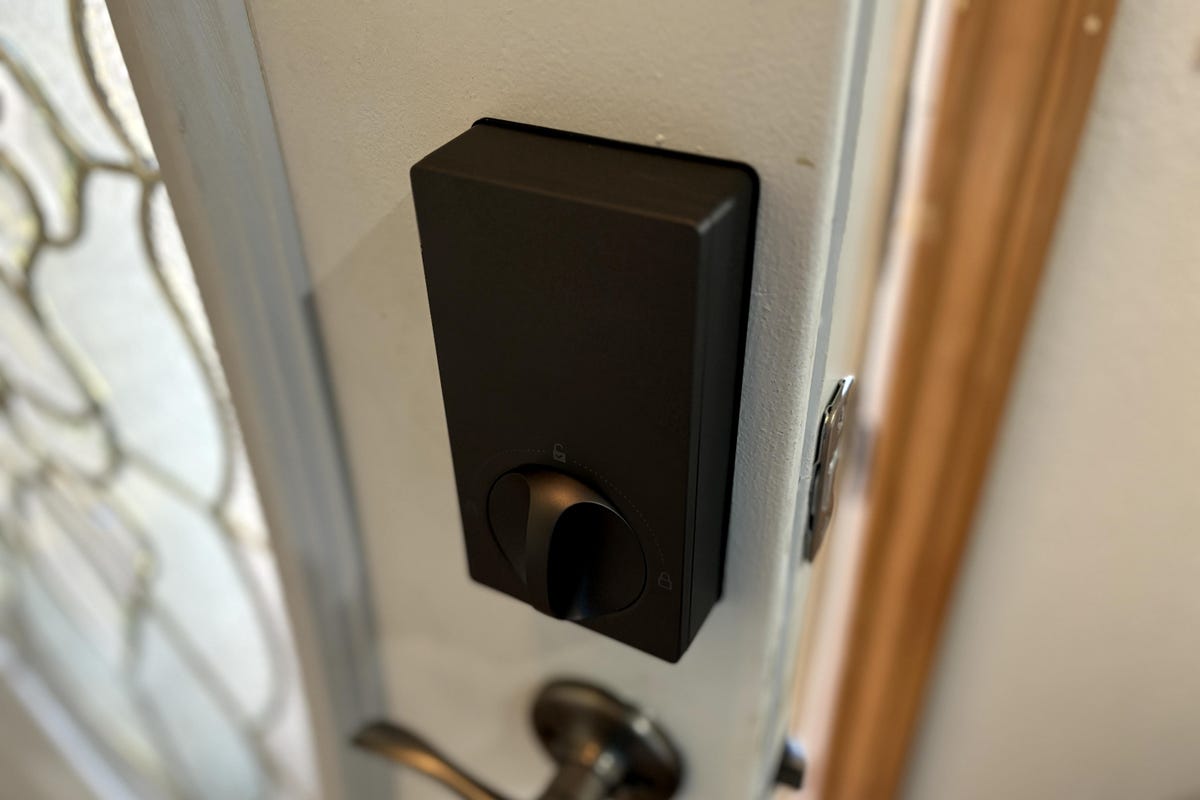
Aqara’s indoor software box is somewhat less durable, but is still highly effect and compact compared to retrofits like August smart locks.
Aqara’s lock arrives with ANSI/BHMA (Builders Hardware Manufacturers Association) level 3 compliance. That’s the lowest of the three levels, but it still provides significant durability, including the ability to withstand two ramming blows at a 75-foot-pound force. It also has IP65 weather resistance so you won’t have to worry about the lock failing in the heat or suffering from rain damage. While I tested it, the weather regularly dropped below freezing during the nights and the lock didn’t appear to notice.
Those specs are important, but the Aqara design is also feels durable compared to many smart locks. The outside section and bolt itself in particular have the best ratings and a strong zinc-alloy design that feels up for anything. The inside section, while somewhat more delicate, does a great job of securing the electronics.
The inside unit also houses the four AA batteries that the lock needs to operate, along with panel-secured buttons for re-setting or re-connecting the lock. These batteries don’t interfere much with the inside design, which is blocky but still compact compared to many alternatives. However, you will need to occasionally replace them: The batteries are rated for around eight months of regular use, and I was unable to make a dent in battery life after several days of frequent tests. There’s a hidden USB-C port for emergency charging when necessary.
A quick note: I tested the matte gray version of the U100, but it’s also available with a silver finish, which does not extend to the keypad itself.
Ease of Installation
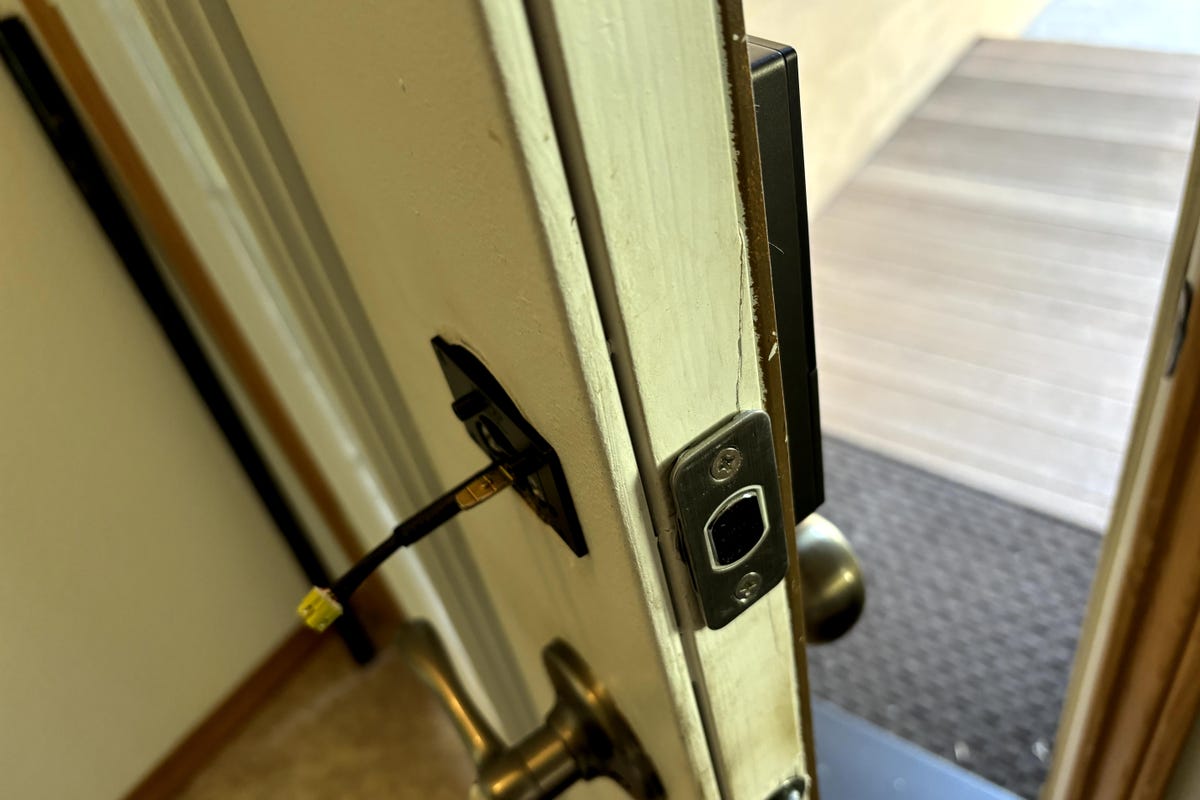
The Aqara lock’s video tutorials are helpful for the DIY installation.
Smart locks take significantly more work to install than many home devices. You can install it yourself, but you’ll want to be ready with careful measuring tools, a drill, screwdrivers of several sizes and most likely a level. Aquara helps where it can, providing twice the number of screws you need and a fold-out measuring chart to apply to your door, among other resources.
But as with most smart locks, there’s no room for error during installation. A millimeter of difference can cause significant problems. Not every front door has the same deadbolt design, so you may also have to get creative. My old deadbolt was a simpler model, for example, so I had to measure and drill screw holes for the larger Aqara bolt. A little persistence, and you should be able to fit the lock into a standard deadbolt door. I recommend taking a look at product measurements, measuring the space around your current deadbolt, and make sure there are no curious design differences that could create trouble when switching to Aqara.
When you first download the Aqara app, you can choose a walkthrough on installing and turning on the door. With these tools and guidance, most owners should be able to complete the project in under 2 hours. If you don’t have much experience with a drill or applying significant force to screws, you may want to enlist the help of someone else, who’ll be able to hold the other half of the lock as you work.
Door locking and unlocking
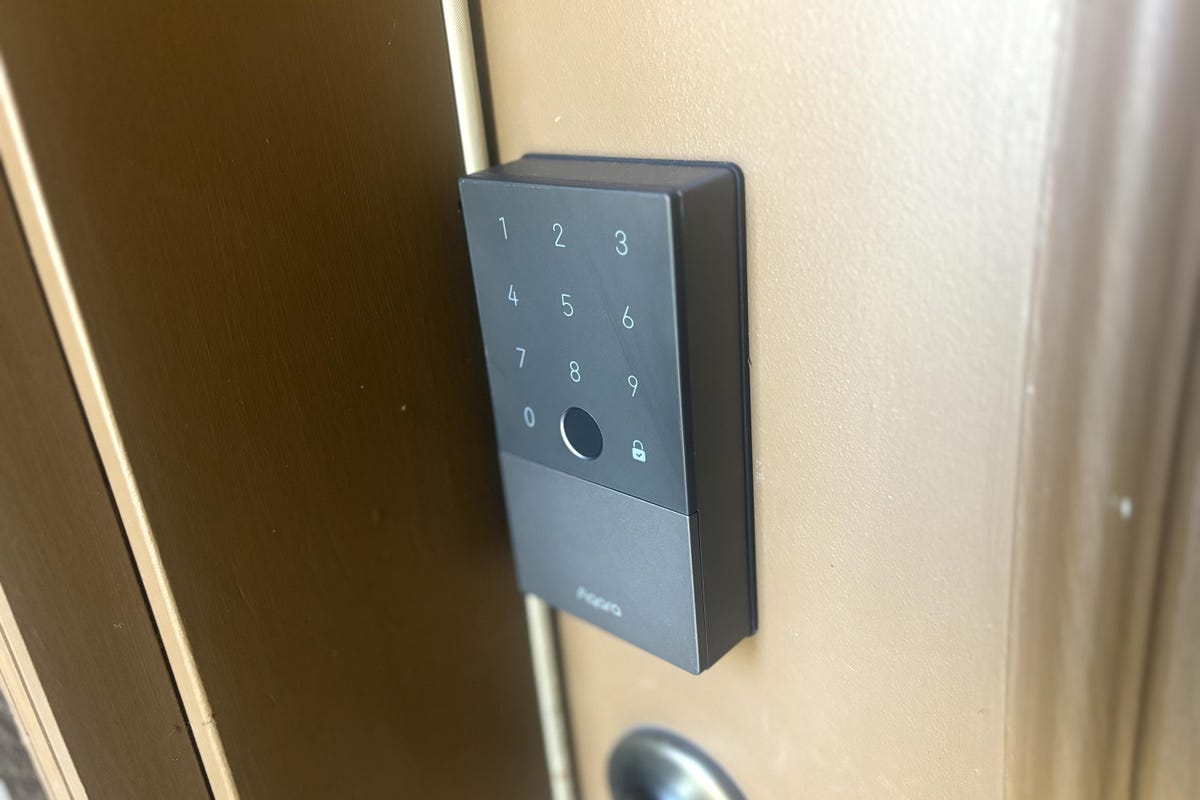
The U100’s keypad feels weighty, responsive and elegant.
Aqara’s plethora of lock management options is welcome. You’re able to pick whichever mode you’re most comfortable with — or whichever you’d prefer guests to use. Share your keypad code, have family members program in their thumbprints, send digital passes or rely on app control — it’s all possible, and you can switch between them based on the circumstances. There’s even a hidden key option in this “keyless” lock in case all other options are blocked.
Operating the keypad is surprisingly satisfying. The touch panel is sensitive, has a very accurate fingerprint sensor and loud chirps/LED indicators to indicate presses. An all-purpose lock button allows you to lock the bolt at a touch or enter the code once it’s completed correctly.
Sensors and smart features
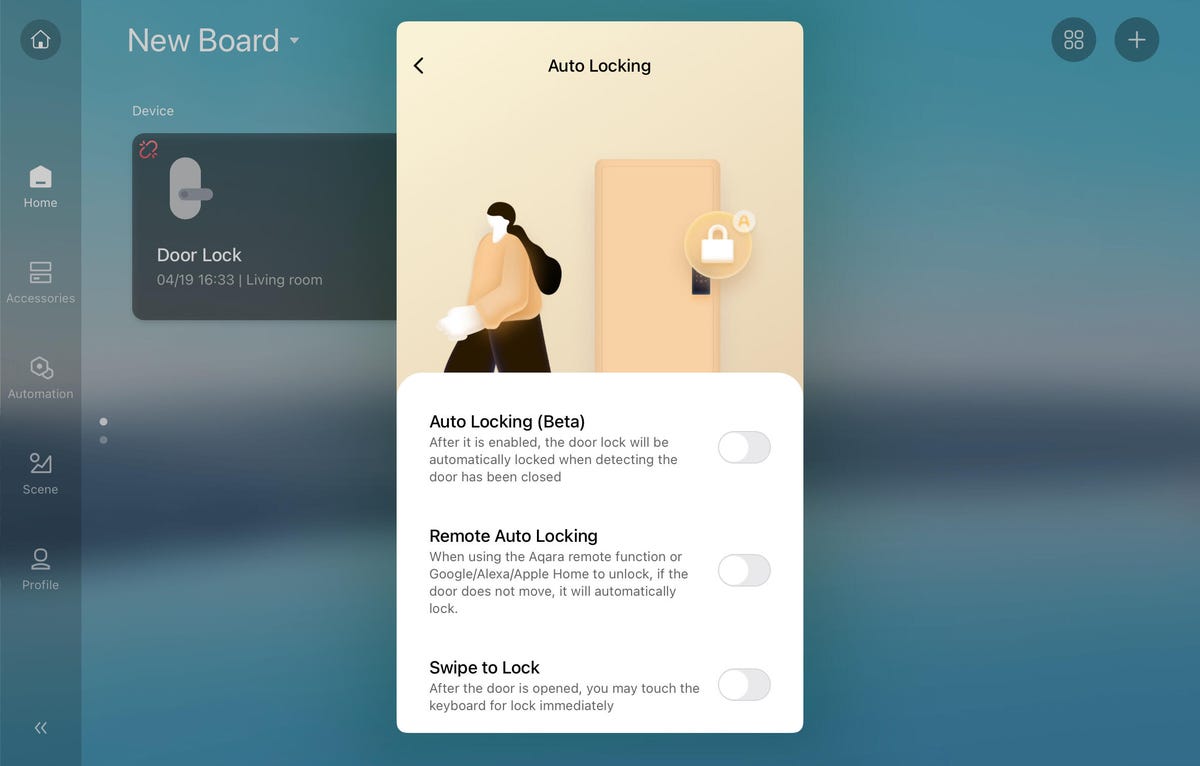
Aqara offers a broad array of methods to control the smart lock’s behavior.
The lock also has more in-depth sensors, including a gyroscope, to detect whether the door is open or closed, or if it has been left accidentally ajar. The Bluetooth function lets you unlock at will, set auto locking or or get alerts based on the status of the door. The auto lock/unlock commands were slightly delayed in the testing, but not enough to make a significant difference. There are also away modes, geofencing options to lock based on device location and other automations to set up. There’s plenty for smart home aficionado to play with, but those other options aren’t necessary if you prefer the basics.
If all that potential activity could cause annoyance, the lock does have a do not disturb mode to quiet down the sounds and alerts. Additional smart features, notably long-distance Wi-Fi control, require an additional hub, which we’ll talk a lot more about below.
App controls and settings
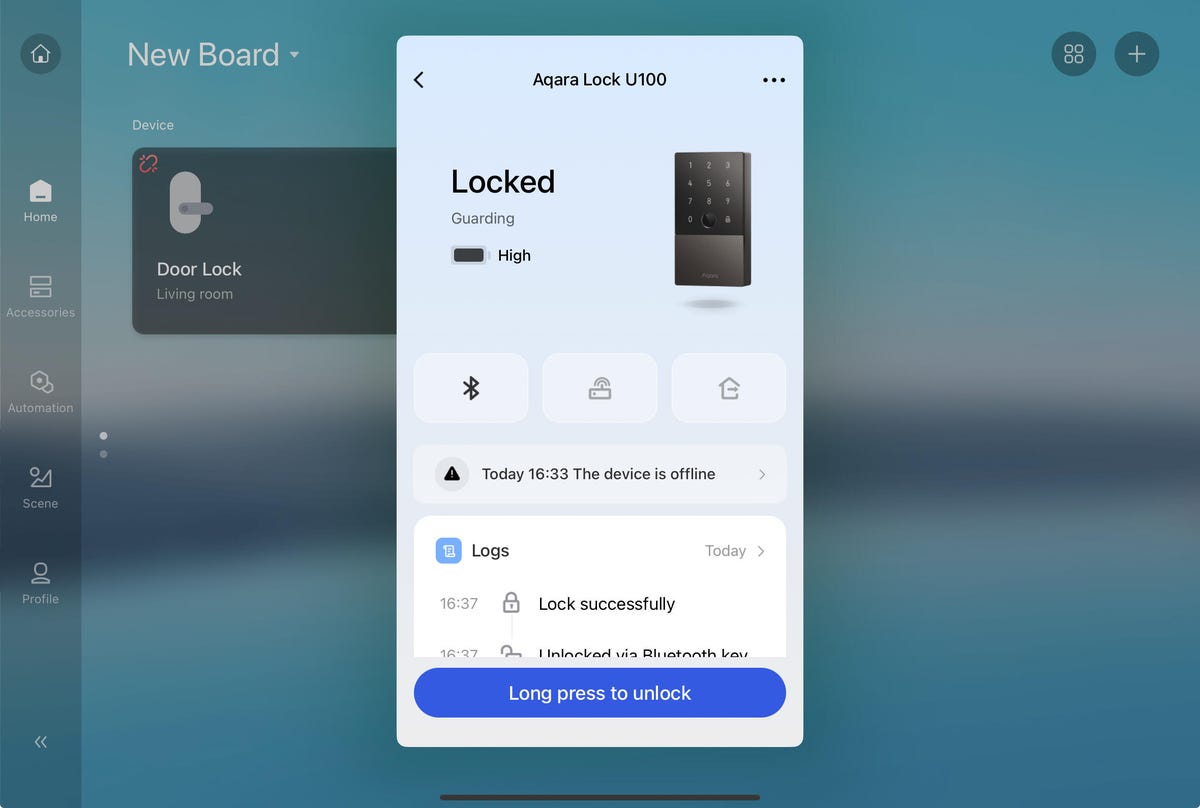
Aqara’s app distills a whole lot of smart lock options into a highly digestible product card.
Aquara’s app works quite well with the U100 smart lock. I liked how the step-by-step installation instructions (which are at times unclear) are always accompanied by much clearer in-app video tutorials. Once it’s set up, it took only a couple of minutes to program sensors, fingerprints and codes to set up functionality. Aqara practices end-to-end 128-bit encryption and only stores fingerprint information locally for security purposes.
While Aqara’s Bluetooth pairing took a few seconds to connect the lock and update whenever I accessed it in my tests, the app controls are excellent once connected and the connection never dropped, even when on the other side of the building. The U100 in-app product card provides a large amount of information at once, and lets you easily tweak settings as needed. You can check on connections, view logs of activity and quickly send one-time passes (also via Bluetooth) or manage users and their fingerprints.
It’s impressive how clear Aqara makes these options, paring down menus that could have been complex into a few easy-to-learn buttons that offer lots of usability but little confusion. The settings will take little time to learn with so many unlocking options (especially if you set up automations like geofencing), but all are easily accessible. The other side of app control is Wi-Fi and smart home support, an area where Aqara does hold a couple of surprises…
Smart home integration
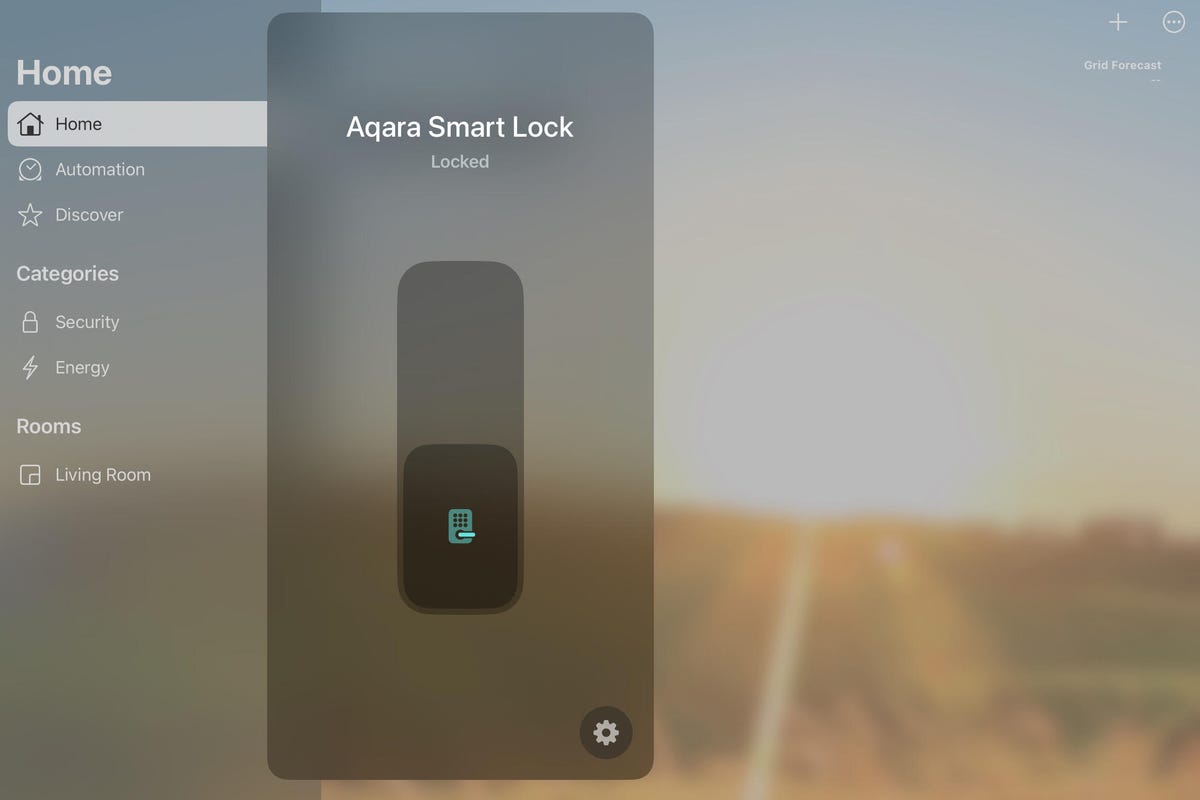
Apple Home allows you to set Aqara guest passes and more.
Aqara’s smart lock works with the Apple Home app right out of the box. Apple Home setup is nearly effortless: I did it in about half a minute with the scan of a QR code, adding the lock to Home and letting users quickly lock or unlock it. The process also adds a card to the Apple Wallet, and gives you the option to create passes and manage guests. It can’t do everything the Aqara app can — no activity log, for example — but it does a lot, and Apple users won’t have to switch between apps if they don’t want to.
Aqara has a bevy of other smart home support options, including the precious Matter compatibility, but there’s a big asterisk here. You need to purchase a separate Zigbeee 3.0 hub from Aqara, such as this plug-in model available for around $50, which is the model I tested the lock with. That enables not only Matter but Google Home/Assistant and Amazon Alexa support, along with Wi-Fi connections for remote control — a fairly important part of smart lock management. It can also chime as your doorbell, among other tricks.
The hub adds so much compatibility and improvements that I highly recommend bundling it with the Aqara U100 if you choose to buy. Unfortunately, this also raises the total price uncomfortably close to $300, a lot to spend on a smart lock. Fortunately, no additional subscriptions are necessary.
Final thoughts on the Aqara Smart Lock U100
The Aqara U100 rises beyond most smart locks through the sheer number of things it can do, from Matter and Apple Home support to fingerprint management and multiple types of passes. The durable design, backed up by end-to-end AES 128 encryption, doesn’t disappoint on any level. Installation may take a bit of extra effort, especially on older deadbolt doors, but it’s well within the means of any DIYer.
The only notable annoyance here is the need for a separate Aqara Zigbee hub to enable many important features, as well as doubling as a doorbell. It’s less a fly in the soup and more a groan from your wallet, but the extra expense is well worth it if you have an outlet or USB spot to spare.


















+ There are no comments
Add yours